The UIAA is delighted to announce that Sierra Madre Nature Trail by University of the Philippines Mountaineers has been named as the 2023 UIAA Mountain Protection Award (MPA) Runner-Up.
The runner-up is one of three prizes offered as part of the annual award. Repurposing Windfarm Blades by Clare Local Development Company, Ireland was named as Best New Initiative on 6 October and the Overall Winner will be announced during the UIAA General Assembly on Saturday 21 October. The UIAA Mountain Protection Award is partnered by the Bally Peak Outlook Foundation.
A total of 12 international projects operational on four continents were showcased as part of 2023 MPA. This year’s nominated projects focus on a number of initiatives including how mountain guides are adapting to shorter and more unpredictable seasons, the introduction of renewable energy to Everest Base Camp and how elite sport climbers are adapting their competition planning and logistics to help offset the impact of climate change.

About the 2023 MPA Runner-Up
The Sierra Madre Nature Trail project aims to traverse and map the entire length of the Sierra Madre, the longest mountain range in the Philippines. The absence of organised efforts to link the disparate trail system has kept it fragmented – a challenge the University of the Philippines (UP) Mountaineers are now tackling head-on. With an indicative route of approximately 815 kilometres, this thru-hike trail aims to be the country’s top contribution to the mountaineering world. At a grassroots level, the initiative makes a point to involve the indigenous communities in the decision-making process and has been powered by volunteerism since its conception. The trail’s overall purpose is to contribute to the conservation of the Sierra Madre forest and biodiversity – among others to save the Philippine crocodile, a severely threatened species.
Discover more about the project here.
“Upon completion, this trail will be a gift to those interested in mountaineering, climbing and outdoor recreational activities. Overall the project focuses on promoting the idea and culture of practicing nature-based tourism with a deliberate and dedicated effort to provide co-benefit to both community (through capacity building, income generation and building sense of ownership) and nature (including regenerative strategies to contribute to forests growth – tree nurseries, tree plantation).”
– UIAA Assessment Team
Following the announcement of the project’s nomination as Runner-Up for 2023, the UIAA spoke to Tope Ordoñez, Project Lead at the University of the Philippines Mountaineers.
UIAA: How do you feel about winning Runner-Up as part of the 2023 UIAA Mountain Protection Award?
University of the Philippines Mountaineers: Pitted against some of the best mountaineering organisations in the world, not to mention their highly innovative and groundbreaking initiatives, even making it as a nominee was already a divine gift in its entirety. To actually win a prize is nothing short of a miracle for us. I really cannot find the perfect words to describe what I’m feeling right now and to contain this excitement until the official announcement will certainly count as a test of mental and emotional fortitude. But I’m up to the challenge as the UP Mountaineers are in seeing the full realisation of the Sierra Madre Nature Trail project.
What do you hope recognition from the UIAA Mountain Protection Award brings to the project?
Credibility. The prize money will help but the recognition will have a longer-term effect on the project. It further validates the efforts put in by our volunteers and justifies the need to push through amidst all the challenges. It keeps the torch that guides us lit, making us remember that our efforts do not go unrecognised and that we are doing a good thing. It helps to know that we are not the only ones who believe in our project.
What inspired the creation of your project?
The year was 1969. Fifteen-year-old Boboy Francisco and three of his basketball teammates summited Mt. Mataba in San Mateo. At the time, it was the nearest he ever got to admiring Sierra Madre up close. “I will see more of you in the coming days,” he promised the “blue mountains” of his toddler years. It was a promise he kept, for he never intended the experience to be just a mere sojourn.
He and five others came to establish the UP Mountaineers (UPM) on April 17, 1977, just a full day ahead of the issuance of the Presidential Decree No. 1636 (PP 1636), declaring portions of Rizal, Laguna, Bulacan, and Quezon as a National Park, Wildlife Sanctuary, and Game Preserve. Right then it was no longer just bagging peaks and linking trails that traverse the entire length of the Sierra Madre. It was no longer just the constant search for their next great adventure. They are in it for the long run, committed to contributing to the conservation of the Sierra Madre forest and biodiversity, as well as its local communities’ inclusive growth. There are millions of indigenous peoples (IP) calling the mountain range their home.
It’s been more than fifty years, and the dream is still alive. The torches that Boboy lit in 1969, we carry up to this day.

Barre des Écrins. Credit: Roeland van Oss

Top of Mont Blanc. Credit: Roeland van Oss
What has been the biggest challenge in mapping the trail network?
Socio-Politic. Much of the trail network is either part of a protected area or ancestral domain or both. We want to do it the right way so instead of going through the mountains as simple trekkers as some groups might do, we go through the processes laid by various Protected Area Management Boards (PAMB), and the National Commission on Indigenous Peoples (NCIP) and its local offices. Ideally, it looks easy enough because these processes are readily available online for us to follow. But on the ground, it is different. There are multiple subgroups, formal and informal, that need to be satisfied with our project but would not engage us if we talked to a rival group first. There are conflicts within government units that we work with that we have no control over. And we just cannot go up there because we also have to consider our safety and security should we go in without proper documentation. The Sierra Madre has some of its areas identified by the Armed Forces of the Philippines (AFP) as areas of insurgency, so we keep them in the loop as well, making sure they have a map of the trail which we never stray away from.
Do you think your project will encourage/inspire more people to walk the trails or even walk the entire length of the network?
The prospect of having to walk a part or the entire indicative 815-km trail is exciting enough yes. It is not a novel pursuit here in the country as two other thru-hikes were established before. One was through the Cordillera Mountains, the Cordillera Great Traverse (CGT), which goes for about 315km, and the other crosses the 408 km island of Cebu, the Cebu Highlands Trail (CHT). In Sierra Madre, there is one other ongoing effort, but it only goes along the coastline mostly. There have only been a few people who completed the CGT and CHT in one go so to do so really raises one’s status as a local mountaineer among fellow outdoor peers.
Yet of course, economics are expected to play a part, for most Filipino trekkers and weekend warriors cannot simply commit to walking more than a day or two in the mountains. That is why it is important to establish local trailheads so people can visit various sections in their own time and try to complete the trail in segments.
We also envision that trail athletes and thru-hikers would see this as a new playground. We have known of some athletes who have run portions of the trail and crossed several provinces in one go. Knowing what they can go through would be a great boon for the project and its beneficiaries.
What benefits will it bring local communities?
A community mapping process will verify the appropriate capacity-building programs that the communities need and are interested in. Alternative livelihood related to these programs will be discussed, ideally centering on cultural ecosystem services such as nature-based tourism, and green spaces. Hopefully, with the additional income, local communities will develop a sense of ownership that is crucial in the protection of the Sierra Madre Mountain Range and the sustainability of SMNT.
How will you address a potential rise in visitors to the trails with the need for conservation?
Since we aim to involve the local communities as much as possible, we will be able to work on a trail management plan with them, together with the other stakeholders like the local government units and national agencies. We are envisioning an umbrella alliance to be founded similar to the Appalachian Trail Conservancy. Protecting Sierra Madre and its trail network is not supposed to be a one-man show, but a collaborative effort between its stakeholders.
Do you aim to network with trail organisations worldwide? Or develop further trail paths in the Philippines?
Yes, we are interested in being a part of the World Trails Network. At this time, however, we do not have any other trail paths on which we are working. We did, however, have trail projects across the country before SMNT, like in the mountains of San Jose, Tarlac; Mt. Pinatubo in Central Luzon, Mt. Guiting-Guiting in Romblon, and a Mt. Matutum Trail in Polomolok, South Cotabato in Mindanao.
How can people support your project?
Equipment and monetary pledges, as well as segment sponsorships, can be useful but people doing their part in protecting Sierra Madre is a more welcome help they can contribute to the project. Hikers need to follow the rules laid by the Protected Area Management Boards. They also need to respect the ancestral domain rights of the local indigenous peoples. Adhering to the Leave No Trace (LNT) principles whenever they are in the mountains is as basic as it can be, but it helps keep Sierra Madre wild. The Sierra Madre Nature Trail won’t be much without the “nature” part.
What do you see as the main challenges in your quest to complete the network?
Funding. Being purely a volunteer-driven project, it pains us to admit that not so many people can commit much of their extra time to working on the various aspects of the project. It is not as simple as just going on hikes now and then, there’s the equally important stakeholder consultation and onboarding that also needs to be done. Setting up capacity-building programs and regenerative practices entails multiple site visits and not just a day or two. With proper funding, full-time staff can be hired to take on most of the work for the project, which the volunteers can augment.
Further Reading
Organisation website
UIAA 2023 MPA Nominee Page
Main Partner




